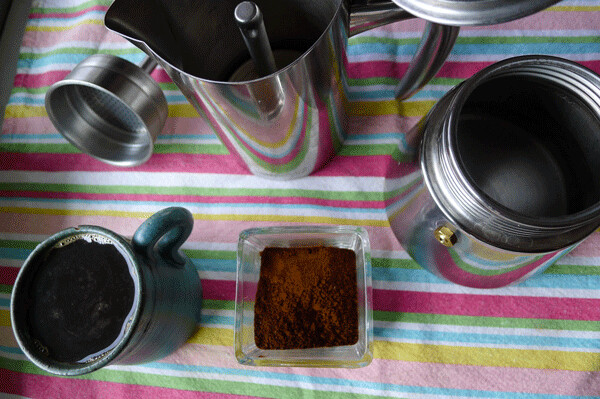Espresso Exceptionalism

When I go to the coffee shop, it isn’t for the coffee. It’s to see and be seen. Maybe do some networking, or tap on my laptop. But unless I’m buying whole beans, I’m not there for the coffee. I’m too much of a snob to let someone else make it.
Plus, I save a lot of money. My daily intake would cost about $10 at the espresso bar, but at home I can stay caffeinated for a week on a $15 sack of freshly roasted beans.
I respect the gentle complexity of a pour over, and the dark intensity of the French press. But espresso is my drink, and I’ll take its tight, focused flavor all day long. Sharp yet smooth, espresso is the purified essence of what I like about coffee.
The first espresso was made in late-1800s Turin, Italy, by forcing steam through coffee grounds. Today’s machines, which can cost north of $20,000, usually use water that’s just below boiling. But the classic stovetop moka pot, invented by Alfonso Bialett in 1933 — and its many imitations — can come remarkably close. With a price point in the mid two-figures, this investment can pay for itself in about a week.
If the home barista plays their grounds right, they’ll see and drink crema, a golden foam of small bubbles, with a laser-focused flavor that‘s the velvety essence of what you want to sip. Crema appears when you have just the right amount of pressure and heat in the coffee chamber, and marks a truly great cup of espresso. You won’t find crema at Starbucks, but an experienced barista with a decent machine should be able to coax a little crema into your shot.
I started with the original, octagonal shaped aluminum Bialetti from a yard sale. Then I picked up a $35 stainless steel AMFOCUS online. I will always love that machine for being the one that was there when I made my quantum leaps, but now I’m totally into my $50 stainless Bonvivo.
The other thing you need is a burr grinder, which uses two spinning metal spools to crush the beans to a uniform size. Whether you want a coarse grind for a French press, a medium grind for drip coffee maker or a fine espresso grind, consistent particle size will make your equipment run properly. If you’re using the (sadly, all too) common spinning blade type, you might as well be hacking at your beans with a frying pan.
My Baratza Virtuoso lists for $250, and is worth every penny. It replaced my $35 Cuisinart, which got the job done, if loudly and slowly. (Luddites: Hand-held burr grinders start at about $15).
A moka pot contains three pieces: a lower chamber to which you add water; a “filter basket” in the middle, where the grounds go; and a spouted collection chamber on top, where you watch for crema. Each unit is different, and I haven’t tested enough models to make any recommendations.
Both of mine can hold about two cups of water in the lower chamber, although the Bonvivo holds slightly more water, and can hold slightly more grounds. Both make the best coffee with about a cup of water and 3 tablespoons of the finest grounds, loosely added. Adjust this ratio if your moka pot is larger or smaller. If you prefer an even more intense shot, use even less water. You’ll get more crema that way too.
If there is too much coffee, the little valve on the lower chamber will release before the coffee has barely started. As the water chamber loses steam, the grounds burn in the filter basket, and the few drops of coffee that make it through the spout will taste of burnt plastic. A coarser grind will allow you to put more coffee in the filter basket without jamming it, but won’t really make a stronger cup of coffee, as you are limited by the coarse grind.
The ideal cup of stovetop espresso has just the right amount of grounds to force up the pressure, and the right amount of water to end on a flurry of crema. Too much water and that icing on the cake will be doused by weak, off-tasting coffee, the result of espresso made from spent grounds.
As for the beans themselves, find a roast, or preferably a roaster. I like a lighter roast than most, even in my espresso, but that’s a topic for a different column.
If you really want to overachieve, heat the water, pre-measured, for the pot, while you grind the beans. Pour the boiled water into the lower chamber, slip in the filter basket and add the grounds, loosely, without tamping or even tapping. Shake slightly, if necessary, to make the grounds somewhat level. Screw the top on, using a hot pad for the base part that’s got a cup of hot water in it.
Place it on the stove. If using a burner, don’t let the flames creep around the bottom and up the sides, and if that’s inevitable, don’t let them melt the handle (my Bonvivo has a metal handle, which is nice). As it heats, watch your moka pot like a hawk — and get used to doing so, daily, for the rest of your life. The first fluid to emerge will be dilute, almost clear, but soon will darken. The crema will melt into the coffee almost as quickly as it appeared, but the espresso excellence it represents will remain.
When the water is mostly through, turn off the heat and pour it. Don’t try to cook out every last drop, as you’ll end up cooking your pot. It may keep sputtering a little, and there will always be liquid left in the lower chamber. Let it go. It tastes like a pile of burnt, dirty laundry. A non-snob might drink it, but we have better things to sip.

